 |
New York Architecture Images-Soho Bowery Savings Bank Landmark |
|
architect |
Stanford White of McKim, Mead and White |
|
location |
130 Bowery |
|
date |
1895 |
|
style |
Classical Revival |
|
construction |
|
|
type |
Bank |
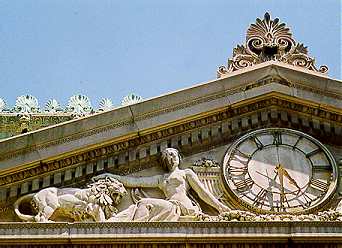 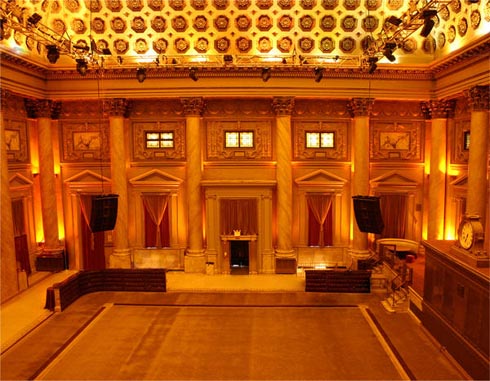 |
|
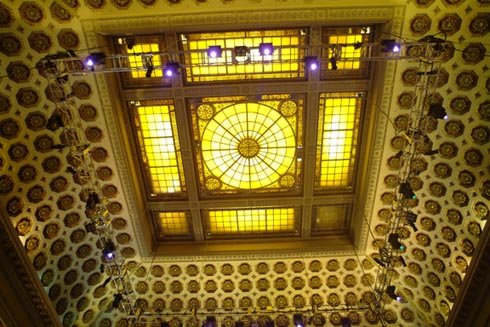 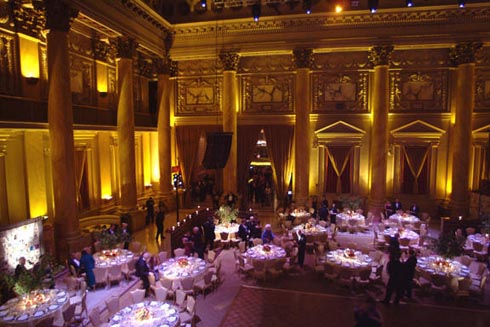 |
|
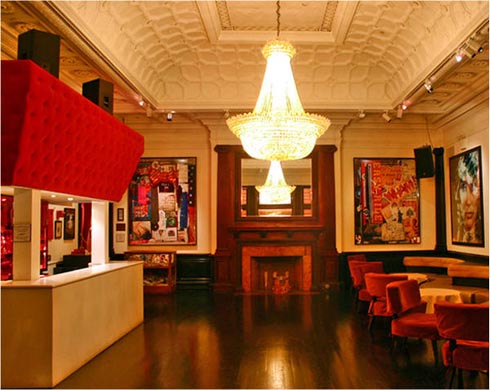 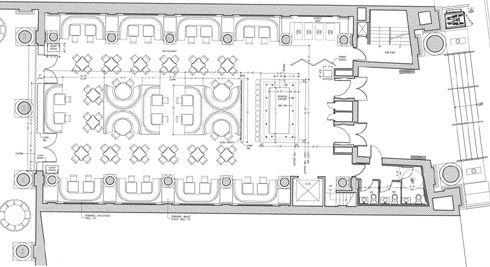 |
|
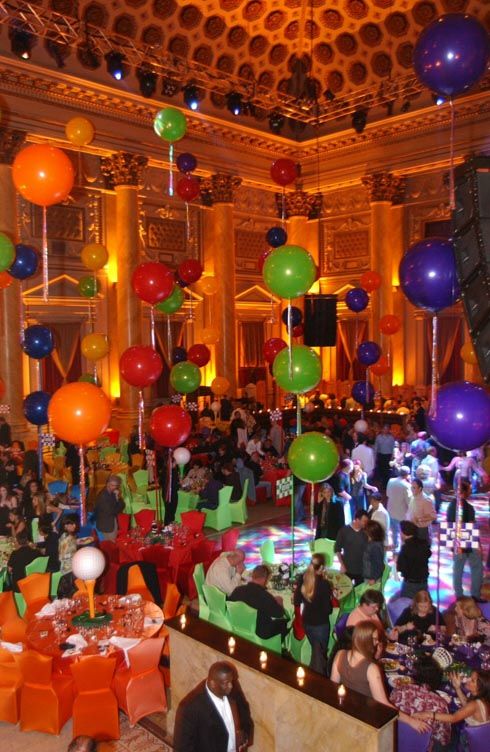 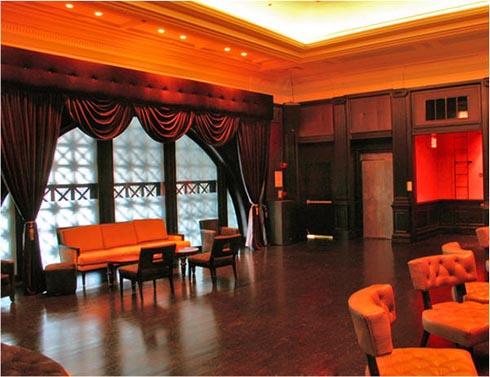 |
|
|
Stanford
White, one of America’s most
prominent architects, was born in 1853. His creativity, talent and
versatile draftsmanship were responsible for the foundation in the
1880’s of one of the country’s most prestigious architectural firms,
McKim, Mead and White.
During his prominent career, White was commissioned to design a broad range of private residences and public institutions, some of which are historical landmarks today. From the homes of New York’s exclusive families to one of the country’s most renowned entertainment arenas, his designs continue to leave many in awe. White’s architectural portfolio includes The Washington Square Arch, a Fifth Avenue mansion formerly owned by the Rockefeller family, The New York Herald building, The Tiffany building, The Boston Public Library, several branches of The New York Public Library, and The Bowery Savings Bank building, which is now home to New York’s hottest event space and restaurant, Capitale. Located at 130 Bowery, Capitale’s 40,000 square foot space is not only impressive in size, but also in structure. This Roman classic 1895 landmark is adorned with Corinthian columns, Venetian glass, marble mosaic floors and 65-foot ceilings. Capitale is a multi-level, multi-room venue equipped to accommodate private parties from 2 to 1,300 guests. White’s decorative style was also seen through his design of jewelry, furniture, and interiors. In 1906, at one of White’s most recognized buildings, his life was ended. While attending the opening of Madison Square Garden's roof show, White was shot and killed by the jealous husband of his mistressThe popular movie Ragtime (the last film with James Cagney ) features the life of Stanford White. Capitale interior features tall Corinthian columns, a beautifully decorated coved ceiling, and an art glass skylight making the Capitale's ballroom one of New York's great function spaces.The full impact of the Beaux Arts architecture of Chicago's Columbian Exposition is evident in this space built in 1893, the year the fair opened. Its limestone exterior is enriched with Corinthian pilasters, columns, and a pediment bedecked with sculptures by Frederick MacMonnies |
|
|
February 6, 2005
SQUARE FEET From the Outside, They Still Look Like Banks By C. J. HUGHES 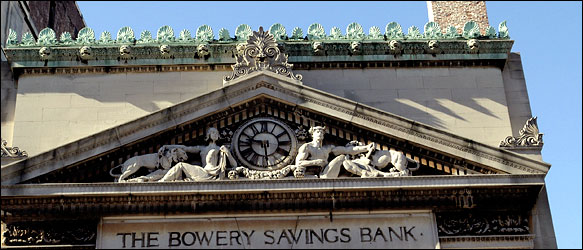 NOW BANQUET HALL The Bowery Savings Bank, 130 Bowery at Grand Street, designed by Stanford White in 1895, is now Capitale, site of bar mitzvahs and weddings. The new location, in a lofty 25,000-square-foot former bank on the northwest corner of West 14th Street and Eighth Avenue, will surely please those who thought the previous 6,000-square-foot store on the Avenue of the Americas, now a Citarella, was too cramped. The move may also thrill fans of Beaux-Arts architecture. The three-story bank, built in 1897 for the New York Savings Bank but for the past decade a carpet showroom, retains cream-colored pilasters under a blue-patterned ceiling. Rather than mute these historic details, Balducci's plans to call attention to them, so shoppers at the first-floor deli counter or in the second-floor restaurant can appreciate the craftsmanship. "Frankly, what we are about is selling classic foods, and here we are in a setting that is itself a classic," said Balducci's chief executive, Mark Ordan. "There's a lot of symmetry here." Balanced pairings of this sort seem to have caught on elsewhere. From Wall Street to Midtown, turn-of-the-20th-century bank buildings - somber, towering tributes to the power of capitalism, some designed by titans of American architecture - now house banquet halls, theaters, fashion boutiques, shoe stores and spas. Yet replacing teller booths with aromatherapy stations requires extensive remodeling, especially since the exteriors of many former banks cannot be altered. Some banks, like the one Balducci's is using, also have landmark status inside. Because of those restrictions, Balducci's will spend $2 million on improvements, including a cooling system for the refrigerator generators, Mr. Ordan said. Opening the safe in the basement cost $7,500, he said. Mr. Ordan would not disclose details of Balducci's lease, but a commercial broker said ground-floor retail rents in the area average $100 to $125 per square foot annually. Such renovations can introduce larger audiences to some remarkable buildings, which in turn can insure they stay protected, according to preservationists. "It's been a really positive trend of the last five years," said Charles Belfoure, architect and author of the book "Monuments to Money: the Architecture of American Banks," scheduled for release by McFarland in March. "Even if the reuse isn't very creative, it's better to get something in there rather than knocking any of it down." For banks whose appearance can be changed, owners sometimes choose to keep them looking institutional anyway, at least on the outside. "The grandeur makes it that much more special," said William Kim, development director for A. I. & Boymelgreen Developers, which is converting the former East River Savings Bank, a 15-story limestone edifice at 60 Spring Street designed by Cass Gilbert in 1927, into residences. After paying $37 million for the building in 2002, Boymelgreen spent $28 million replacing photography and artist studios with 42 luxury condos; all but one have been sold, Mr. Kim said. Now, the company is turning its attention to the 3,783-square-foot ground-floor space that it hopes to rent for $200 per square foot annually to either a fashion boutique or home-furnishings retailer, he said. But retailing is not always the best answer. Displaying refrigerators and air-conditioners was ultimately seen as a waste of unique space by the Haier Group, the Chinese appliance manufacturer that owns the former Greenwich Savings Bank, built in 1924 at 1356 Broadway at West 36th Street. After using the main hall of the building as a sales showroom for a few months, in August 2002 Haier renamed the cavernous 70-foot-high space Gotham Hall and began renting it out for exclusive private events like college fund-raisers and fashion shows. Why build such evocative Greek temples to begin with? To inspire confidence. When the United States economy collapsed in the Panic of 1893, many people blamed banks for the depression that followed and withdrew their money. So, banks built in that era (until the end of the Great Depression, when banks began to demystify themselves with glass-fronted branches) were meant to suggest strength, as if they had been there forever. The former Bowery Savings Bank at Grand Street, designed by Stanford White in 1895 with a glowing amber glass ceiling and a buffed terrazzo floor, is now the site of bar mitzvahs and weddings as Capitale, a banquet hall that opened in October 2002. "I think any reasonable person who looks at a building as historical as this would want to preserve it," said the owner, Seth Greenberg, who has spent $4 million to rehabilitate the 36,000-square-foot space. Farther uptown, at the old Union Square Savings Bank, created by Henry Bacon, who designed the Lincoln Memorial, is the Daryl Roth Theater. Its tall ceilings were ideal for the acrobatic troupe De La Guarda, which performed there from 1998 till last September. Now, after months of painting, polishing and rewiring, the theater is ready for a new play, probably by this summer. "It's funny these old buildings can work for you and against you," said the general manager, Adam Hess, citing how difficult it was to move equipment through the narrow doors. Although on a high-visibility corner and slightly elevated off the sidewalk, the Union Square bank draws attention to its function without much flash. Today, a bank branch can also be midblock, with a neon-bright marquee, mannequin window displays and shimmering glass and chrome fixtures. "It's all about colors and comfort levels," said Lee Carpenter, chief executive of Design Forum, which designed Washington Mutual's 30 Manhattan branches. "It was all about matching the physical experience with a corporate brand," one that emphasizes a casual, interactive experience, he said. Though older banks may be more formal, sharp-eyed commercial developers began to see their potential about a decade ago. In 1996, the Memorial Sloan-Kettering International Center moved into a well-scrubbed Art Deco berth, with a clock still ticking over its front door, at 1429 First Avenue, at East 74th Street. In the same year, Blue Water Grill opened in the former Bank of the Metropolis facing Union Square. With the trend catching on, the restaurateur Giuseppe Cipriani opened a 15,000-square-foot banquet hall in the old Bowery Savings Bank branch on East 42nd Street, opposite Grand Central Terminal, in 1999. The same year, developers added 11 condos upstairs at the old New York County National Bank, on the southwest corner of Eighth Avenue and West 14th Street, opposite Balducci's; its downstairs is home to Nickel spa for men. Uptown on Eighth Avenue, at West 43rd Street, the boxy 1927 Manufacturers Hanover Bank houses the Second Stage Theater, its ticket window tucked snugly into the basement safe. Still, time has not treated every old bank branch kindly. An unremarkable conversion of the First Federal Savings and Loan Association at 237 First Avenue, at East 14th , has left it with a series of pharmacies. And the former First National City Bank of New York, a prominent 1928 building at Canal and Broadway, is almost unrecognizable under a grab bag of shops selling cheap jewelry, berets and scarves. Maybe its best chance at salvation is to welcome back tellers. 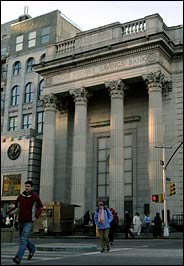 NOW A THEATER The Union Square Savings Bank, at 15th Street, was designed by Henry Bacon. It is now the Daryl Roth Theater. Copyright 2005 The New York Times Company
|
|
|
links |
|